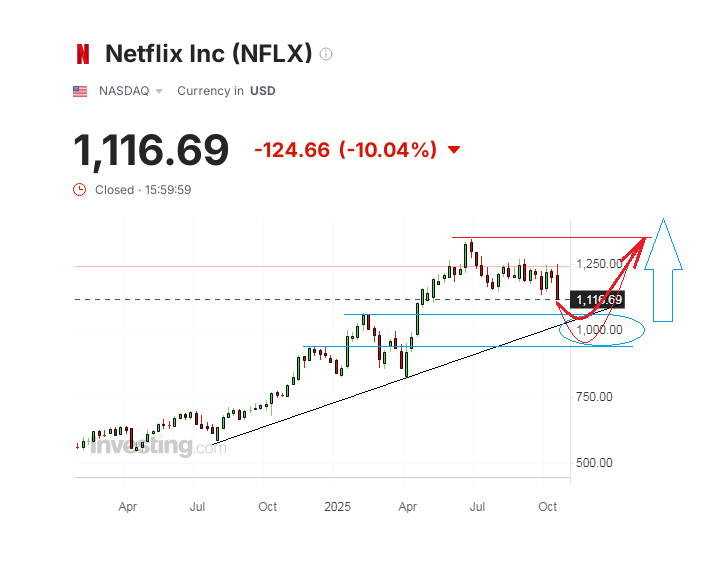Netflix, Inc. (NASDAQ)
- By date
- Metadoro first
Shares of Netflix tumbled by more than 10% this Wednesday. There you are, my Precious... So juicy sweet... Stupid fat tax laws... You ruins it... New and strange Brazil tax rules... They stole it from us... We are lost, lost... No business, no Precious, nothing... Only empty... Well, enough Gollum's emotional quasi quotes by J.R.R. Tolkien here. In substance, sales of Netflix's streaming products still remain strong and even become better after climbing another 17% YoY from $9.82 billion to $11.51 billion, including 3.8% QoQ vs $11.08 billion. Still very steep growth, good pace. Even US and UK engagement just hit record levels, up 15% and 22% respectively from late 2022, citing data from Nielsen and Barb, as Netflix itself has stopped providing subscriber numbers in its earnings report to attract more attention to financial indicators. Well, this is exactly what happened, but no shareholder is happy except future shareholders who sleep and see in their dream how to buy some stake in Netflix as cheap as possible.
Netflix has become much cheaper, sliding to around $1,115 so far, from their previous June peaks of nearly $1,350 just months ago, and could possibly even dive into the $1,000 area or even briefly dip below this mark - all due to an unexpected profit shortfall. In fact, profit numbers would have been more than needed to continue Netflix rising rally, as profit grew quarter after quarter through those points at $4.27 bln, $6.61 bln, $7.19 bln consecutively, but now it nominally fell sharply to just $5.87 bln instead of breaking new all-time records. This happened because Netflix CEOs decided to take into account fresh Brazilian tax payments, deeming that the further efforts on legal disputes could be unproductive. Thus, a painful $619 million tax expense is associated with a 10% tax on certain payments made by Brazilian entities to foreign counteragents. In this case, Netflix Brazil pays Netflix US for services that enable Netflix Brazil to offer subscriptions to its Brazilian customers. This had not previously been factored into the company's results and projections. But it became clear that the company has high chances to finally lose the litigation on the case. And this became a potential loss to knock the operating margin for Netflix‘ September quarter.
Providing more colour on what happened, CFO Spencer Neumann stressed “two really important takeaways" that he wanted to share. "The first is that … no other tax looks or behaves like this in any other major country in which we operate. And, secondly, absent this expense, we would have exceeded our Q3 ‘25, operating income and operating margin forecast. And we don’t expect this matter to have a material impact on our results going forward”. Without the Brazilian "culprit", Netflix's operation margin would have exceeded the company’s previous guidance of 31.5%. But they reported an operating margin of 28% after accounting the loss. This national tax on outbound payments is called the Contribution for Intervention in the Economic Domain (CIDE). It’s not a tax that’s specific to Netflix or streaming businesses. Other companies would probably be impacted as well, even though many of them believed that it may apply only to service payments that involve a transfer of technology. Netflix actually "received a favorable ruling from a lower court back in 2022" that concluded "we were not subject to this tax, which is why we believed we couldn’t accrue this”, according to Spencer Neumann. But in August, the Brazil Supreme Court decided against another unrelated company, ruling that “the tax applies to a wider range of transactions than we thought was legally permissible,” including service payments. “So given that court’s ruling, that’s caused us to revaluate the likelihood of prevailing, and we now deem the loss to be probable, and that’s why we recorded the expense in Q3”, he added.
I've gone into such detail because I thought the details were important. Netflix's business can't be harmed by a tax in one country for long, even if it were to be implemented. At worst, they'd simply raise subscription prices for Brazilians and blame their government for the measure. Netflix's other financial metrics are remarkably good. The company noted its record advertising sales. According to co-CEO Greg Peters, Netflix could more than double its advertising revenue YoY. Since Netflix introduced discounted ad-supported subscriptions not long ago, it has yet to provide the exact size of its advertising business. They didn't do it yet, creating an impression that its steady revenue growth is still primarily driven by standard subscriptions and leaving even more room for my dreams on future growth via a rather new channel of ad-supported subscriptions.
In short, I therefore see no reason not to add Netflix stocks at cheaper prices. Speaking of content, I've already written about Christmas time, coming sooner than you blink your eyes, and Christmas holidays always represent a profitable season. Key releases right now also include the final season of Stranger Things, new seasons of The Diplomat and Nobody Wants This, as well as Guillermo del Toro's Frankenstein and Rian Johnson's Wake Up Dead Man: A Knives Out Mystery. The latter movie is exactly what I am personally eager to see. And all of this will happily wake up Netflix stock, I believe, as it is far from being a dead asset.

Netflix, Inc. (NASDAQ)
| Ticker | NFLX |
| Contract value | 100 shares |
| Maximum leverage | 1:5 |
| Date | Short Swap (%) | Long Swap (%) | No data |
|---|
| Minimum transaction volume | 0.01 lot |
| Maximum transaction volume | 100 lots |
| Hedging margin | 50% |
| USD Exposure | Max Leverage Applied | Floating Margin |
|---|









